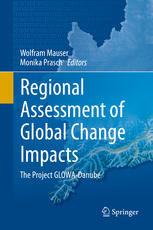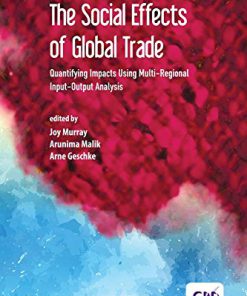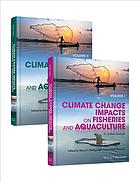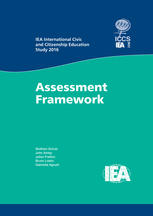Regional Assessment of Global Change Impacts The Project GLOWA Danube 1st edition by Wolfram Mauser 9783319167510 3319167510
$50.00 Original price was: $50.00.$25.00Current price is: $25.00.
Regional Assessment of Global Change Impacts The Project GLOWA Danube 1st edition by Wolfram Mauser – Ebook PDF Instant Download/Delivery: 9783319167510, 3319167510
Full download Regional Assessment of Global Change Impacts The Project GLOWA Danube 1st edition after payment

Product details:
• ISBN 10:3319167510
• ISBN 13:9783319167510
• Author:Wolfram Mauser
Regional Assessment of Global Change Impacts
The Project GLOWA-Danube
This book provides an overview of the GLOWA-Danube research project from 2001 to 2011, a transdisciplinary initiative which explores the future of water resources in the Upper Danube Basin. It documents the purpose and unique approach, architecture, methodologies, scenarios and results of the project, creating a scientific knowledge base for the dialogue of stakeholders and scientists. The book offers a possible blueprint for successful global change science through integrative and transdisciplinary co-creation of knowledge and orientation for regional adaptation within the context of the Future Earth research program.
Regional Assessment of Global Change Impacts The Project GLOWA Danube 1st Table of contents:
Part I: Introduction
Chapter 1: GLOWA-Danube
1.1 The GLOWA-Danube Project
1.2 GLOWA: Early Transdisciplinary Research for Global Change
1.3 GLOWA-Danube and Stakeholders
1.4 The Upper Danube as a Pilot River Basin
1.5 Climate Change in the Upper Danube Basin
1.6 Global Climate Change and the Effects that Can Already Be Perceived
1.7 Perspectives on Global Change in the Upper Danube Basin
1.8 Scenarios
1.9 The Upper Danube Basin Global Change Atlas
References
Chapter 2: DANUBIA: A Web-Based Modelling and Decision Support System to Investigate Global Chang
2.1 Overview
2.2 Concept
2.2.1 Main Components and Interfaces
2.2.2 Spatial Concept
2.2.3 Temporal Concept
2.3 DANUBIA Core System
2.3.1 Developer Framework
2.3.2 Runtime Environment
2.4 The User Interface
2.5 The DeepActor Framework
2.5.1 Life Cycle of a DeepActor Model
2.5.2 Decision Process of a Deep Actor
References
Chapter 3: DeepActor Models in DANUBIA
3.1 Introduction
3.2 Features of Multi-actor Modelling
3.3 The DeepActor Framework
3.4 The Concept of Flags in the DeepActor Models
References
Chapter 4: Validation of the Hydrological Modelling in DANUBIA
4.1 Introduction
4.2 The Hydrological Model PROMET as a Supplement to DANUBIA
4.3 Validation of the Model
4.3.1 Annual Water Balance
4.3.2 Daily Run-Off
4.3.3 Return Periods of Extremes
4.4 Summary
References
Chapter 5: The Stakeholder Dialogue in the Third Project Phase of GLOWA-Danube
5.1 Implementing DANUBIA Globally – The Stakeholder Dialogue in the Third Phase
5.2 Structuring of the Stakeholder Processes
5.3 Realisation of the Stakeholder Dialogue
5.4 Results and Conclusion
Chapter 6: GLOWA-Danube Results and Key Messages
6.1 Introduction
6.2 The Methodological Approach of GLOWA-Danube
6.3 The Regional Development of Climate
6.4 The Development of Society
6.5 Water Balance
6.6 Water Consumption and Water Supply
6.7 Winter and Summer Tourism
6.8 Agriculture and Forestry
6.9 Industrial Water Usage
Part II: Data
Chapter 7: Digital Terrain Model
7.1 Introduction
7.2 Data Processing
7.3 Results
References
Chapter 8: Soil Textures
8.1 Introduction
8.2 Data Processing
8.3 Results
References
Chapter 9: Land Use and Land Cover
9.1 Introduction
9.2 Data Processing
9.3 Results
References
Chapter 10: Climate Stations
10.1 Introduction
10.2 Data Processing
10.3 Results
Reference
Chapter 11: Spatial and Temporal Interpolation of the Meteorological Data: Precipitation, Tempera
11.1 Introduction
11.2 Data Processing
11.2.1 Temporal Interpolation
11.2.2 Spatial Interpolation
11.3 Results
References
Chapter 12: Ice Reservoir
12.1 Introduction
12.2 Data Processing
12.3 Results
References
Chapter 13: Trends in Temperature and Precipitation
13.1 Introduction
13.2 Data Processing
13.3 Results
13.3.1 Temperature
13.3.2 Precipitation
References
Chapter 14: Hydrogeology – A Consistent Basin-Wide Representation of the Major Aquifers in th
14.1 Introduction
14.2 Data Processing
14.3 Results
14.3.1 Base Class 1
14.3.2 Base Class 2
14.3.3 Base Class 3
14.3.4 Base Class 4
14.3.5 Base Class 5
14.3.6 Base Class 6
14.3.7 Base Class 7
14.3.8 Base Class 8
14.3.9 Base Class 9
14.3.10 Base Class 10
References
Chapter 15: Mean Daily Discharge and Discharge Variability
15.1 Introduction
15.2 Data Processing
15.3 Results
References
Chapter 16: Population
16.1 Introduction
16.2 Preparation of the Data
16.3 Description of the Model
16.3.1 Calculation of Proxel Values
16.3.2 Configuration of the 5 × 5 Matrix
16.4 Presentation of the Results
References
Chapter 17: Gross Domestic Product
17.1 Introduction
17.2 Data Preparation
17.3 Description of the Model
17.4 Presentation of the Results
References
Chapter 18: Water Demand in Tourism Facilities
18.1 Introduction
18.2 Data Processing
18.3 Results
References
Chapter 19: Agriculture
19.1 Introduction
19.2 Data Processing
19.3 Results
References
Chapter 20: Extraction of Water for Public Drinking Water Supply
20.1 Introduction
20.2 Data Processing
20.3 Results
References
Chapter 21: Topsoil Organic Carbon Content
21.1 Introduction
21.1.1 Data Processing
21.2 Results
References
Chapter 22: Data on Quantity and Quality of Groundwater
22.1 Introduction
22.2 Data Processing
22.2.1 Groundwater Quantity
22.2.2 Groundwater Quality
22.3 Results
References
Chapter 23: Hydropower Plants
23.1 Introduction
23.2 Data Processing
23.3 Results
References
Part III: Models
Chapter 24: Groundwater Recharge
24.1 Introduction
24.1.1 Data Processing
24.1.2 Model Documentation
24.2 Results
References
Chapter 25: Run-Off Formation
25.1 Introduction
25.2 Data Processing
25.3 Model Documentation
25.4 Results
25.4.1 Analysis of Long-Term Behaviour
Chapter 26: Groundwater Contour Maps for the Alluvial Aquifers of the Upper Danube Basin
26.1 Introduction
26.2 Data Processing
26.3 Model Documentation
26.4 Results
References
Chapter 27: Total Extraction and Total Water Supply per Community
27.1 Introduction
27.2 Data Processing
27.3 Model Documentation
27.4 Results
References
Chapter 28: Modelling the Effects of Global Change on Drinking Water Supply: The DeepWaterSupply
28.1 Introduction
28.2 Data Processing
28.3 Model Documentation
28.4 Results
References
Chapter 29: Surface Water: Discharge Rate and Water Quality
29.1 Introduction
29.2 Data Processing
29.3 Model Documentation
29.3.1 Modelling Water Flows
29.3.2 Modelling Water Quality
29.4 Results
References
Chapter 30: Mean Snow Cover Duration
30.1 Introduction
30.2 Data Processing
30.3 Model Documentation
30.4 Results
References
Chapter 31: Future Changes in the Ice Reservoir
31.1 Introduction
31.2 Model Documentation
31.2.1 Subscale Extrapolation
31.2.2 Change in Mass and Surface Area
31.3 Results
References
Chapter 32: Precipitation and Temperature
32.1 Introduction
32.2 Data Processing
32.3 Model Documentation
32.4 Results
References
Chapter 33: Two-Way Coupling the PROMET and MM5 Models
33.1 Introduction
33.2 Coupling Area
33.3 Land Use Classification
33.4 Two-Way Coupling
33.5 Results
33.6 Conclusion
References
Chapter 34: Mean Number of Storm Days
34.1 Introduction
34.2 Data Processing
34.3 Model Documentation
34.4 Results
References
Chapter 35: Energy: Simulation of Hydropower Generation and Reservoir Management
35.1 Introduction
35.2 Data Processing
35.3 Model Documentation
35.3.1 Simulated Annual Output
35.3.2 Reservoir Management
35.4 Results
References
Chapter 36: CO2 Fluxes and Transpiration
36.1 Introduction
36.2 Data Processing
36.3 Model Documentation
36.4 Results
References
Chapter 37: Plant Growth and Biomass Production
37.1 Introduction
37.2 Data Processing
37.3 Model Documentation
37.4 Results
References
Chapter 38: Nitrate Leaching
38.1 Introduction
38.2 Preparation of the Data
38.3 Description of the Model
38.4 Presentation of the Results
References
Chapter 39: Agricultural Land Use and Drinking Water Demand
39.1 Introduction
39.2 Data Processing
39.3 Model Documentation
39.4 Results
References
Chapter 40: Actor Model for Farmers’ Crop Management Decisions: The DeepFarming Model
40.1 Introduction
40.2 Data Processing
40.3 Model Documentation
40.4 Results
References
Chapter 41: Water Demand by Private Households and the Public Sector
41.1 Introduction
41.2 Data Processing
41.3 Model Documentation
41.4 Results
Reference
Chapter 42: Modelled Domestic Water Demand 2: The DeepHousehold Decision Model
42.1 Introduction
42.2 Data Processing
42.3 Model Documentation
42.3.1 Water Use Types
42.3.2 Plans
42.3.3 Events
42.3.4 Attributes
42.3.5 The Decision Process
42.4 Results
References
Chapter 43: Diffusion of Water-Saving Technologies in Private Households: The Innovation Module o
43.1 Introduction
43.1.1 Innovation Research
43.2 Data Processing
43.3 Model Documentation
43.4 Results
References
Chapter 44: Modelling Risk Perception and Indicators of Psychosocial Sustainability in Private Ho
44.1 Introduction
44.2 Data Processing
44.3 Model Documentation
44.4 Results
References
Chapter 45: Environmental Economy: Industrial Water Abstraction
45.1 Introduction
45.2 Preparation of the Data
45.3 Description of the Model
45.4 Presentation of the Results
References
Chapter 46: Tourism Research: Water Demand by the Tourism Sector
46.1 Introduction
46.2 Data Processing
46.3 Model Documentation
46.4 Results
References
Part IV: Scenarios
Chapter 47: GLOWA-Danube Scenarios
47.1 Introduction
47.2 Formation and Logic of the GLOWA-Danube Scenarios
47.3 Scenario Period
47.4 Scenario Selection
References
Chapter 48: The GLOWA-Danube Climate Trends
48.1 Introduction
48.2 Selection of the Emission Scenario
48.3 Translation of the Global Emission Scenario into a Global Climate Trend
48.3.1 Results of the Intergovernmental Panel on Climate Change IPCC
48.3.2 The Global Basis for the REMO and MM5 Regional Climate Models
48.4 Application of the Predictions of the Global Climate Models to the Upper Danube Basin
48.4.1 The Regional Climate Trends from IPCC and ECHAM5–MPIOM
48.4.2 Trends in Temperature and Precipitation Within the Upper Danube Basin Analysed Using REMO
48.4.3 Regional Climate Trends Calculated with the MM5 Climate Model
48.4.4 The Regional Climate Trend from Historical Climate Measurement Data
48.4.5 Synopsis of the Regional Climate Trends
References
Chapter 49: The Statistical Climate Generator
49.1 Introduction
49.2 Step 1: Statistical Analysis of the Historical Measurement Data from the Climate Monitoring
49.3 Step 2: Generation of Weekly Climate Time Series from a Specified Climate Trend
49.4 Step 3: Generating New Data Series Using Regrouping of Historical Data
49.4.1 Weekly Patterns in the Climate Trends
49.4.2 Validation of the Statistical Climate Generator
49.5 Conclusion
References
Chapter 50: The GLOWA-Danube Climate Variants from the Statistical Climate Generator
50.1 Generating the Climate Variants
50.2 Climate Variants in GLOWA-Danube
50.3 Conclusion and Outlook
Chapter 51: Climate Variants of the MM5 and REMO Regional Climate Models
51.1 Regional Climate Models
51.2 Downscaling and Bias Correction of the Model Results
51.3 Results
51.3.1 Temperature
51.3.2 Precipitation
51.4 Summary
References
Chapter 52: Societal Scenarios in GLOWA-Danube
52.1 Introduction
52.2 The Scenarios
52.3 The Sinus Scenarios
52.3.1 Free is Fair Scenario
52.3.2 Shared Destiny Scenario
52.4 The Societal Scenarios in GLOWA-Danube
52.5 Methodology
52.5.1 Step 1: Assessing Suitability
52.5.2 Step 2: Scenario Description
52.5.3 Step 3: Implementation Specific to the Sub-projects
52.5.4 Step 4: Scenario Drivers
Reference
Part V: Integrative Results
Chapter 53: Impact of Climate Change on Water Availability
53.1 Introduction
53.2 Water Availability
53.3 Discharge
53.4 Conclusion
Chapter 54: Scenarios for the Development of Low Flow in the Upper Danube Basin
54.1 Introduction
54.2 The Future Development in Low Flow at Gauge Achleiten
54.3 The Regional Development of Low Flows in the Upper Danube Basin
54.4 Summary
References
Chapter 55: Scenarios for the Development of Floods in the Upper Danube Basin
55.1 Introduction
55.2 The Future Development in Flood Status at Select Gauges in the Upper Danube Basin
55.3 Spatial Trends in the 100-Year Peak Discharge
55.4 Summary
References
Chapter 56: Influence of the Glaciers on Runoff Regime and Its Change
56.1 Introduction
56.2 Data Processing
56.3 Results
56.4 Summary
References
Chapter 57: Mean Snow Cover Duration from November to June Under the REMO Regional Climate Trend
57.1 Introduction
57.2 Data Processing
57.3 Results
Chapter 58: Trends in Evapotranspiration of Heterogeneous Landscapes Under Scenario Conditions
58.1 Introduction
58.2 Data Processing
58.3 Model Documentation
58.4 Results
References
Chapter 59: Groundwater Recharge Under Scenario Conditions
59.1 Introduction
59.2 Results
59.2.1 Trends of the Scenarios
59.2.2 Spatial Changes
59.2.3 Temporal Change
Reference
Chapter 60: The Influence of Snow Cover on Runoff Regime and Its Change
60.1 Introduction
60.2 Data Processing
60.3 Results
Reference
Chapter 61: Analysis of Discharge Patterns on the Danube between Kelheim and Achleiten with a
61.1 Introduction
61.2 Limitations for Inland Shipping
61.2.1 Regulation Low Water Level (RNW)
61.2.2 Highest Navigable Water Level (HSW)
61.3 Conclusion
References
Chapter 62: Effects of Different Scenarios on the Operating Dates of Ski Areas
62.1 Societal Scenarios in the Tourism Model
62.1.1 The Tourism Model in the Baseline Societal Scenario
62.1.2 The Tourism Model in the Performance Societal Scenario
62.1.3 The Tourism Model in the Sustainability Societal Scenario
62.2 Implementations
62.3 Selected Results from the Scenario Runs
References
Chapter 63: Effects of Different Scenarios on Water Consumption by Golf Courses
63.1 Introduction
63.2 Behaviour of the Golf Actors in the Three Different Societal Scenarios
63.3 Implementation
63.4 Selected Results from the Scenario Runs
63.5 Potential Interventions and Options
References
Chapter 64: Changes to the Quantitative Status of Groundwater and the Water Supply
64.1 Introduction
64.2 Model Components and Calculation Methods Involved
64.3 Scenario Assumptions
64.4 Results
64.4.1 Map 64.1
References
Chapter 65: Societal Scenarios in DeepHousehold
65.1 Introduction
65.2 Data Processing
65.2.1 Baseline Scenario
65.2.2 Performance Scenario
65.2.3 General Public Interest Scenario
65.3 Results
Reference
Chapter 66: Scenarios with Economic Perspectives Under the Impact of Climate and Social Changes
66.1 Introduction
66.2 Changes to Industrial Groundwater Use
66.3 Industrial Groundwater Use in the Different Scenarios
66.4 Trends in the Gross Regional Product
66.5 Gross Regional Product in the Different Scenarios
References
Chapter 67: Interventions in DeepHousehold
67.1 Introduction
67.2 Interventions in DeepHousehold
67.3 Results
67.4 Outlook
Chapter 68: Effects of Climate Change on Hydropower Generation and Reservoir Management
68.1 Introduction
68.2 Change in the Mean Simulated Annual Output in the Subbasins
68.3 Reservoir Management Over the Course of a Year Using the Example of the Gepatsch Reservoi
68.4 Summary and Outlook
References
Chapter 69: Estimating the Change in Groundwater Quality Resulting from Changes to Land Use and
69.1 Introduction
69.2 Methodology
69.2.1 Calculation of Groundwater Vulnerability
69.2.2 Calculation of the Probability of Export
69.2.3 Calculation of the Dynamic Groundwater Quality Index (GWQ Index)
69.3 Validation Using Measurement Data on Groundwater Quality
69.4 Results
References
Chapter 70: Effects of Future Climate Changes on Yields, Land Use and Agricultural Incomes
70.1 Introduction
70.2 Scenario Assumptions
70.3 Model Components Involved
70.4 Results
References
Chapter 71: Soil Temperature under Scenario Conditions
71.1 Introduction
71.2 Data Processing
71.3 Model Documentation
71.4 Results
References
Chapter 72: Effects of Climate Change on Nitrate Leaching
72.1 Introduction
72.2 “Agriculture” Model Assembly
72.3 Assumptions of the Scenarios
72.4 Results
References
Chapter 73: Effects of Agro-Economic Decisions on Nitrate Leaching
73.1 Introduction
73.2 Assumptions of the Scenarios
73.3 Description of the Model
73.4 Presentation of the Results
References
Chapter 74: Climate-Related Forest Fire Risk
74.1 Introduction
74.2 Description of the Forest Fire Module
74.3 Results
74.3.1 Hydroclimatic Change
74.3.2 Forest Fire Risk
74.4 Conclusion
References
Chapter 75: Forest Fire Risk Under Various Climate Trends
75.1 Introduction
75.2 Data Processing
75.3 Results
75.4 Conclusion
Reference
Chapter 76: Effects of Future Climate Trends on Crop Management
76.1 Introduction
76.2 Scenario Assumptions
76.3 Model Components Involved
76.4 Results
References
Index
People also search for Regional Assessment of Global Change Impacts The Project GLOWA Danube 1st:
regional assessment of global change impacts
regional impacts of climate change
regional impacts
regional effects of climate change
regional changes
You may also like…
Education Studies & Teaching
Science (General)
History - American Studies
Climate Change Impacts on Fisheries and Aquaculture: A Global Analysis, I Bruce F. Phillips
Computers - Programming
An Elementary Introduction to the Wolfram Language 2nd Edition Stephen Wolfram
Education Studies & Teaching
Politics & Philosophy
Education Studies & Teaching












